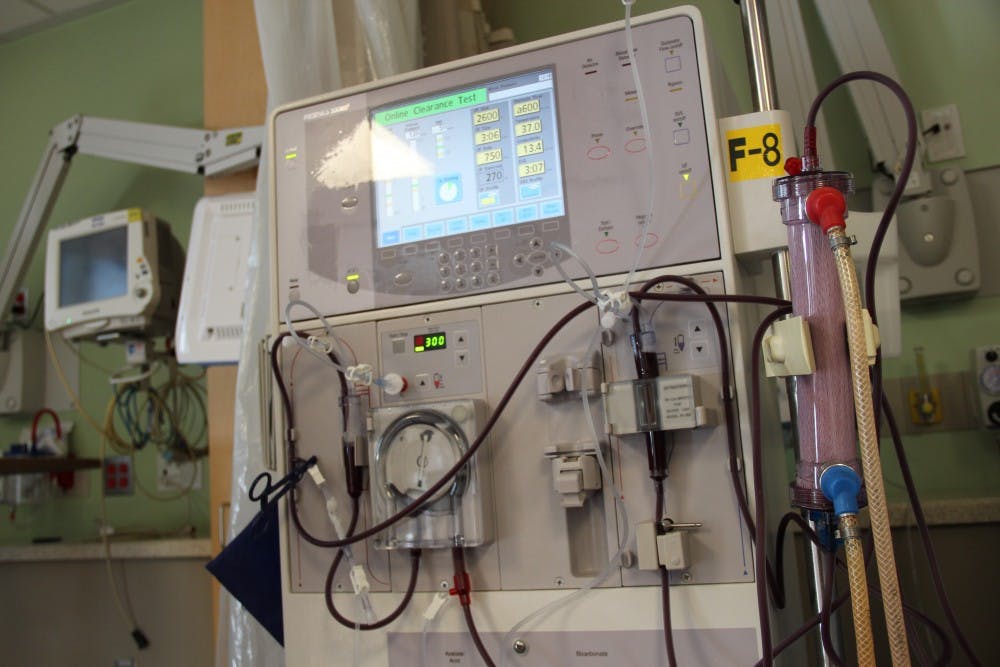Of the 660,000 Americans receiving treatment for kidney failure, 468,000 are undergoing dialysis. Now a team of engineers at Hopkins have developed a device that reduces the risk of infection in at-home dialysis. Their work will make it even more efficient for patients to perform dialysis at their own convenience.
Dialysis has three main functions: to remove waste, salt and extra water from building up in the body; to keep steady levels of potassium, sodium and bicarbonate in the blood; and to help control blood pressure.
These functions are usually covered by healthy kidneys, but when an individual develops end-stage kidney failure, losing 85 to 90 percent of their kidney function, dialysis is the answer.
There are two types of dialysis: hemodialysis and peritoneal dialysis. For hemodialysis, an artificial kidney known as a hemodialyzer is employed to perform all the functions of a regular kidney. This method typically involves a minor surgery to the arm or leg.
Peritoneal dialysis is where the blood is cleaned inside the body via a surgery that puts a catheter into the abdomen so that the abdominal area, also known as the peritoneal cavity, gets filled with dialysate that draws out the extra fluid and waste products in the blood.
Dialysis may be conveniently done at home, but because the procedure is administered by the patients themselves, there is a high risk of contamination during the treatment setup.
The infection, peritonitis, would then require hospitalization 60 percent of the time and is the primary factor in one in six peritoneal dialysis patient deaths. The infection occurs in one in four patients, so it is an epidemic that should receive a considerable amount of attention.
This is the problem that Dr. Alicia Neu, a professor of pediatrics at Hopkins Hospital introduced to a team of biomedical engineering undergraduates.
Sarah Lee, the leader of the team, explained in an interview with The News-Letter how they were intrigued by the problem.
“Our team thought it seemed like a clear unmet need that could allow us to have a significant potential impact,” Lee said.
Lee and her fellow team members Anna Bailey, Tejasvi Desai, Giang Hoang, Eugene Oh and James Qin founded Relavo, a company aiming to develop a device to reduce the risk for contamination during peritoneal dialysis treatments. The result was PeritoneX — an affordable, disposable device that works to disinfect the contamination points for a dialysis treatment.
The team has been on a winning streak with PeritoneX. At Texas Christian University’s Richards Barrentine Values and Ventures Competition, Lee, Bailey and Desai won an honorable mention recognition as well as a cash prize of $2,500. They also won $1,000 from Intuit Education for the best financial forecast.
They were also the recipients of the $10,000 Summer Undergraduate Entrepreneurship Award and another $10,000 grant from FastForward U’s Ralph S. O’Connor Undergraduate Entrepreneurship Fund. These cash prizes are both a part of the Johns Hopkins Technology Ventures, which is the licensing, patent and technology commercialization office that aims to guide emerging startups inside and outside Hopkins.
Bailey believes that winning has generated momentum and morale.
“It’s been surreal. I’ve always known we could be successful, but the grants that we’ve gotten so far have really served to boost our confidence and our dedication to the project,” Bailey said. “Our device could have a huge potential impact once it makes it to market. Having that validated really adds to our momentum.”
Lee explained how the funds help move PeritoneX one step closer to reality by taking away some financial constraints. The Relavo team has their sights set on bigger and better things in the near future — namely larger regional and national grant programs this year.
Another barrier to product development has been finding time to dedicate to the project. The team has to juggle their coursework and other activities.
“We are still in the product development phase, but one of the biggest challenges we’ve had is time — all of us are so passionate about this project, but it’s hard to put as many hours as we want into this while still maintaining full course loads. It can be hard to keep momentum going when everyone is busy with midterms and problem sets,” Lee said.
After the semester is over, however, the group will have more time to dedicate to the project. They believe that they will be able to make larger strides towards the final product during this time.
“We’re especially excited for the summer — this will give us a solid chunk of continuous time to devote to the project,” Lee said.
The team plans to complete product development by the end of the summer so that they will have mature prototypes next year. Then they will begin verification testing to eventually submit to the Food and Drug Administration for 510(k) market clearance.





